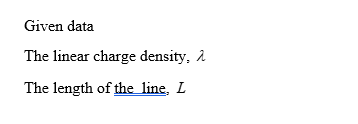Find the EF at distance z above one end of a straight line segment of length L that carries a uniform charge 1. Check that your formula is consistent with what you would expect for the case z>>L. (FIGURE 1)
Find the EF at distance z above one end of a straight line segment of length L that carries a uniform charge 1. Check that your formula is consistent with what you would expect for the case z>>L. (FIGURE 1)
Related questions
Question
100%
EF stands for Electric Field
Should require integration for both problems. Please show step by step for better understanding, Ty! :)

Transcribed Image Text:1. Find the EF at distance z above one end of a straight line segment of
length L that carries a uniform charge 1. Check that your formula is
consistent with what you would expect for the case z>>L.
(FIGURE 1)
P

Transcribed Image Text:2. Find the EF at distance z above the center of a square loop of
side a that carries a uniform line charge ›.
(FIGURE 2)
•P
Expert Solution
Step 1: Given data

Step by step
Solved in 5 steps with 5 images
